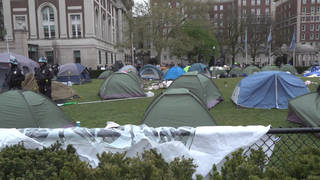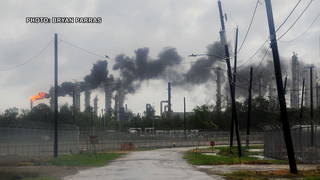
Related
Guests
- Joseph Rommeditor of the blog ClimateProgress.org. He is a Senior Fellow at the Center for American Progress and was Acting Assistant Secretary of Energy for Energy Efficiency and Renewable Energy during the Clinton administration.
- Perry BeemanStaff writer for the Des Moines Register. He has written a number of award-winning investigative pieces on agribusiness and the environment in Iowa. He is a former president and board member of the Society of Environmental Journalists.
The words “extreme weather” are rarely associated in the mainstream media with another two words: “global warming.” But scientists argue that these extreme weather events are consistent with changes they have long predicted would accompany global warming. We speak to Joseph Romm of ClimateProgress.org and Perry Beeman of the Des Moines Register. [includes rush transcript]
Transcript
AMY GOODMAN: We’ve all come to know the words “extreme weather.” Wildfires rage across California, and a state of emergency is declared in several counties. Torrential rain in the Midwest and historic levels of flooding from Iowa to Missouri. At least six people are killed by tornadoes in Iowa and Kansas. A heat wave on the East coast has claimed the lives of a number of people. In China, people have barely had time to recover from the recent earthquake. Flooding and rain have killed over sixty and left over a million people homeless. Meanwhile, record drought in many parts of the United States and Australia continue.
The words “extreme weather” are rarely associated in the mainstream media with another two words: “global warming.”
But scientists argue these extreme weather events are consistent with changes they have long predicted would accompany global warming.
We turn now to climate blogger and scientist Joseph Romm. He’s a senior fellow at the Center for American Progress, was Acting Assistant Secretary of Energy for Energy Efficiency and Renewable Energy during the Clinton administration. We’re also joined on the phone from Des Moines by environmental journalist Perry Beeman. He’s an award-winning investigative reporter for the Des Moines Register. We welcome you both to Democracy Now!
I want to begin with the big picture. Joseph Romm, can you talk about what’s happening around the world and how it is conveyed to us?
JOSEPH ROMM: Sure. Well, I think that to any objective observer, the weather has definitely gotten more extreme. We hear more about these record floods, not just in Iowa, but in Great Britain and in China. We’re seeing the spread of drought and deserts in places like Australia, and here, of course, in the United States, more intense rainfall, more extreme heat, record wildfires.
And in general, the media is covering this as this all sort of unconnected events, just regular weather maybe gone a little wacky. But, in fact, the scientific community has predicted for more than two decades now that as we pour more heat-trapping greenhouse gases into the atmosphere, the planet will heat up, and that would redistribute water. If you heat up the planet, then places that are kind of arid will lose soil moisture, and they’ll become drier, whereas you put — you heat up the planet, you evaporate more water, and areas that are wetter will tend to see more intense rainfall and deluges and earlier snowmelts, and all that will lead to flooding. So what we’re seeing is exactly what scientists have been telling us would happen because of human emissions.
AMY GOODMAN: Why do you think this lack of coverage, of making the connection? I mean, the coverage of the extreme weather is pervasive; it is extensively covered on all of the networks.
JOSEPH ROMM: Well, there is a couple of reasons, one of which is —- and if you read the work of Ross Gelbspan, a Pulitzer Prize— winning reporter from Boston, he talks about how those who oppose action on global warming and those who are skeptical of global warming have worked very hard to attack the media whenever they point out this connection. I think — so I do think that that is part of the reason.
I also think that part of the reason is that the people who write about global warming for most newspapers and TV are not the same people as those who tend to cover weather. You know, the New York Times has a reporter who covers global warming, and he’s quite good, but he is not the guy who goes to Iowa to write about the flooding there. So I think this is a failure of the editors at newspapers, whose job is to sort of assign reporters and look at the big picture. And I say this as someone — my father was a newspaper editor for thirty years, so that was his job, was to figure out the big picture and educate his readers.
AMY GOODMAN: And what is the connection, for example, between the wildfires that have raged in places like Santa Cruz to Sacramento, to the flooding we see in Iowa, to what’s happening now in China, the very place where the earthquake devastated Sichuan province, now the terrible rains and flooding?
JOSEPH ROMM: Well, I think global warming puts more water vapor into the atmosphere, and so you are — what you are expected to see is more rain, but not just any type of rain, but rain that comes in very intense downpours over one or two days, you know, that we would call deluges. So that is something we expect.
Wildfires are quite interesting, because they have multiple causes. Obviously, when it’s dry and hasn’t rained for awhile and the soil is drier, you’re going to see wildfires. But the other thing that has occurred across much of the country and Canada is that pests, particularly the so-called bark beetle, used to be wiped out in the winter — the larvae used to be wiped out by very cold winters, but since winters aren’t as cold anymore, the larvae survive. So we’ve had these huge infestations of bark beetles that, for instance, have pretty much — they’re on track to a wipe out every harvestable pine tree in British Columbia. And when you combine drier soil with more pests, and the trees, of course, need water to produce the sap to fight off the beetles.
And then, finally, the other piece you see is the earlier snowmelt. A lot of the West doesn’t get rainfall in the summer and early fall. In order to stay moist, what has happened traditionally is that the snow has melted slowly over the course of the summer, and the streams have provided water and humidity for the West. But now, because of global warming, the snow is melting earlier and earlier, so that gets you (a) the more intense streams and flooding in the early — in the late spring and early summer, and then you just get very dry by the midsummer and late summer, and so you get more wildfires.
And although wildfires don’t get a lot of attention in this country, except when they hit Californian homes, it might surprise people to know that since the year 2000, the United States has lost in wildfires an area of trees equal to the state of Idaho. We have seen record-breaking wildfire season after record-breaking wildfire season.
AMY GOODMAN: We’re talking to Joseph Romm. He runs the blog “Climate Progress” at climateprogress.org, senior fellow at the Center for American Progress. We’re also joined by Perry Beeman, staff writer for the Des Moines Register
. Are you dry right now, Perry?
PERRY BEEMAN: Well, we’re dry in most parts of Des Moines. The north of downtown in Des Moines, we have an area where we had a levee break, that people are just now being able to survey the damage, and it’s still very wet up there. The eastern part of the state is still pretty much a disaster zone along several of the major rivers.
AMY GOODMAN: First, can you sum up what the state of Iowa looks like right now from Cedar Rapids to Iowa City to Des Moines? What are the reports coming in?
PERRY BEEMAN: Well, we have — we now still have 36,000 people who are out of their homes. They’ve been evacuated. Cedar Rapids, the water is falling, but we went from 100 blocks covered to 400 blocks, and I think it was somewhere over a thousand yesterday. A lot of the central — just a lot of the very heavily developed neighborhoods in downtown Cedar Rapids are under. The river is falling there.
Iowa City, the Iowa River crested yesterday, which is good news, but the University of Iowa is seeing flooding in places it never has on record. This is a flood that’s worse than 1993 in places in Iowa, and those are two places that it definitely is worse than ’93.
In Des Moines, it was at least equal to ’93, but there has been less damage, because there were considerable improvements made after ’93. Interestingly, though, the levee that broke the other day that flooded a reasonably poor area and one of the major Des Moines high schools, at least surrounded that high school with water, is a levee that was a known problem in ’93. The Corps has a plan to fix it, but so far has — Congress hasn’t appropriated money to even design the levee. And so, it was one of these that was improperly built, it got saturated, and it failed. In ’93, it was overtopped. So, in some cases, we haven’t fixed problems we knew about. And in many cases, in particular in a suburban area of Des Moines that is prone to having, you know, six or seven feet of water in a major flood, there’s not a drop of water in that district this time around. So there’s good news and bad news.
AMY GOODMAN: You’re the former president of the Society of Professional Journalists. What about that?
PERRY BEEMAN: Society of Environmental Journalists.
AMY GOODMAN: Sorry?
PERRY BEEMAN: Society of Environmental Journalists.
AMY GOODMAN: Of Environmental Journalists, I meant.
PERRY BEEMAN: Right.
AMY GOODMAN: What about that issue of connecting extreme weather, which is getting extensive coverage, to global warming?
PERRY BEEMAN: Well, interestingly enough, in my reporting for the Des Moines Register, just not even a few weeks before this all happened, we were in the middle of doing a climate change series that’s going to run over the year, and I had just examined that very issue. In fact, we had a double truck or two-page spread graphic talking about the different things that would happen and pointing out just what the previous speaker has said, that you would expect more torrential rains.
We had — Cedar Rapids had twelve inches of rain in ten days leading up to this event. And I believe that the eastern part of the state was averaging ten to fifteen percent — sorry, ten to fifteen inches of rain since May 15. We had a tornado in Parkersburg in the eastern part of the state that killed eight on May 25, and on June 13, we had one of the — the Boy Scout camp in Little Sioux that killed four from Nebraska and Iowa.
And so, you know, my thing on this is that you can’t really — just as you can’t always attribute something that looks like an environmental exposure to cause an illness because there may be other factors, it’s hard to say definite cause and effect, but what we can say is, based on the international panel — international panel’s work and work at Iowa State University and the University of Iowa, that what has happened here is consistent with many scientists’ view of what global warming will mean in the Midwest.
AMY GOODMAN: The piece you wrote, Perry Beeman, on several groups acting to help the state roll with changes, a team of Iowa State University scientists including several involved in a Nobel Peace Prize-winning report last year by the Intergovernmental Panel on Climate Change, are some of those members of the Intergovernmental Panel in Iowa?
PERRY BEEMAN: Yes, one of my main sources, Gene Takle from Iowa State University. There actually are three or four scientists at ISU who were involved in the international panel, and I think Gene has been involved in previous ones. And then there’s also a center at the University of Iowa; I don’t know that they have been directly involved in the last assessment, but certainly are probably offering technical information.
AMY GOODMAN: You’ve also written about the sewage treatment plants that have just shut down, the sewers also. Can you talk about the problem of the contaminated water all over Iowa?
PERRY BEEMAN: Well, that’s correct. I mean, I was — you know, sewage bypasses unfortunately are a fact of life in Iowa. By “bypasses,” I mean that when they get overloaded with rain, of course, they have to just pretty much shut down and let the water go straight into the river.
A few days ago, the Iowa Department of Natural Resources reported that there wasn’t a single sewage treatment plant in the northeast corner of Iowa on the Cedar, the Wapsipinicon and one other major river up there that was operating. Cedar Rapids’s plant is down and could be down for two weeks. And, of course, what that means is, is all that sewage is, diluted as it may be by the floodwaters, is going to go into the river. And we have now a monitoring program for our state park beaches. When it rains heavily, usually we get pretty high E. coli readings at some of the lakes, and we’ll have beach advisories. And certainly this isn’t going to help.
So we have an infrastructure problem with the sewage treatment plants. Even in Des Moines, we had some flooding downtown that was based on two factors. One is that the storm sewers can’t run into the river if the river is so high it’s covering the pipe that leads into the river. And worse, we have combined sewers. I think Des Moines estimates somewhere around $750 million they need to spend to fix sewers, some of which go back to like 1930, ’40, ’50. They can’t handle the load.
AMY GOODMAN: Cedar Rapids, running out of water, ironically?
PERRY BEEMAN: Well, Cedar Rapids was down to about 25 percent capacity. They were down to their last well. And, you know, maybe your viewers would be interested in knowing that in Des Moines, which lost its water in ’93, we have built a backup water treatment plant. But the main plant also was fortified, and it was never really threatened this time around, and they have several backups. But Cedar Rapids, last I knew, was down to one well, and they were asking people to use as little water as possible. And I believe that FEMA and the National Guard were bringing in bottled water in case they needed that, too.
AMY GOODMAN: I wanted to go to break, then we’ll come back to this discussion. We’re talking with Perry Beeman. He is staff writer for the Des Moines Register, has been writing extensively about the flooding. He’s the former president and board member of the Society of Environmental Journalists. We’re also joined on the telephone from Washington by Joseph Romm, editor of the blog “Climate Progress” at climateprogress.org. We’ll be back with them in a minute.
[break]
AMY GOODMAN: Our guests, Perry Beeman, staff writer for the Des Moines Register; we are also joined by Joseph Romm, editor of the blog climateprogress.org. As we turn now to President Bush in London today for talks with British Prime Minister Gordon Brown, the trip is part of Bush’s final European tour before he leaves office. He spoke about climate change at a news conference at 10 Downing Street.
PRESIDENT GEORGE W. BUSH: Finally, we talked about global climate change and briefed Gordon on our strategy for the major economies meeting to hopefully reach an international goal for 2050 that will have intermediate strategies that are binding on each nation within the UN framework. And the reason why I believe this is the right approach to take, that unless China and India are a part of a binding international agreement — and the United States — then we will not have effective policy in dealing with climate change. It might make us all feel good, but the results won’t be satisfactory. And so, hopefully, you know, in Seoul, South Korea, coming up, there will be a major economy meeting agreement on a long-term goal with binding commitments.
AMY GOODMAN: President Bush in London at 10 Downing Street. Joseph Romm, your response?
JOSEPH ROMM: Well, you know, the administration has been the worst in the world on global warming, and not only has it refused to take any action at home in the United States, it’s fought in the courts, efforts to block the states from taking action, and it’s been working behind the scenes to undermine global action.
There’s no question that if China and India are not a part of a global treaty, we won’t be able to stop catastrophic warming. But, you know, we are the richest country, and we have been responsible for the vast majority of the cumulative emissions over the past two centuries, and everyone expects that we need to show some leadership. We need to take some action to reduce emissions at home. And obviously, if the richest country in the world won’t take some action, why would developing countries like China and India?
So I think, you know, the President’s argument sounds superficially persuasive, but they’ve been saying this for very long time, that we can’t act until poor countries act. And, of course, if you ever talk to people from China or India, they just laugh at the notion that somehow the richest and most powerful country in the world can’t figure out a way to cost-effectively reduce its own emissions and lead on this issue. So I think, you know, the good news is that the next president of the United States is going to take some action on global warming, and, you know, it’s just a few more months left in President Bush’s administration.
AMY GOODMAN: Perry Beeman, I wanted to ask about hog farms in Iowa, the issue of pollution and what’s happening with them with this immense flooding.
PERRY BEEMAN: I don’t have a lot of information on that, but I did talk to the chief of environmental protection for Iowa a couple of days ago, and he said that we do have a couple of hog farms where the — most of them have these concrete storage pits underneath the hog confinements now for manure, and because of all this groundwater and the changing pressures, I think a couple of them have had collapses in those systems and, I assume, some leaking.
Maybe even more serious than even that is that we have these old clay lagoons. They’re sort of the old model; they’re being replaced quickly. But the Department of Natural Resources is concerned that if those pits are not full, then it’s sort of a Catch-22: if the pits aren’t full, then the walls may collapse because of the pressure from the groundwater; if they are full, then they might overflow because of the rain.
So we don’t have — I think right now the sewage treatment plants are probably a bigger issue, but I’m sure that we’ve had, you know, some manure runoff from all of this. Of course, if anybody has applied reasonably lately to the fields, the crop fields, some of that may be running off, as well.
AMY GOODMAN: I also understand that the University of Iowa, which has quite a remarkable museum, was able to get all of its art out secretly before the flood and is now being kept in a secret location in Chicago.
PERRY BEEMAN: You’re wondering if that’s true, you think?
AMY GOODMAN: Well, I assume it’s true.
PERRY BEEMAN: Well, and I guess I don’t have any information on that, although I do — I can say that they evacuated some buildings in Iowa that was — that have never been evacuated for a flood. The Iowa River runs through the middle of Iowa City, and the land to the east of the river rises just pretty dramatically. It’s a river valley, after all. But the amazing thing to me is that they had to evacuate a couple of buildings that are up that hill a ways and had sandbagged those streets. And again, they had water in places that they didn’t have water in ’93.
I do think ’93 was worse, a worse flood in the Des Moines area than it was in Iowa City, but I think the University of Iowa has been pretty aggressive at getting a lot of its valuables out. And, of course, the Old Capitol, I think, is not threatened with water, but it would be kind of ironic if that building had damaged, since they just replaced the dome that had burned a few years ago. That’s the symbol of the university.
AMY GOODMAN: I want to thank you both very much for being with us, Perry Beeman, staff writer for the Des Moines Register, former president of the Society of Environmental Journalists, and Joseph Romm, runs the blog at climateprogress.org.












Media Options